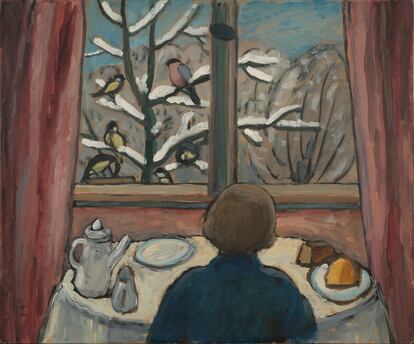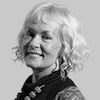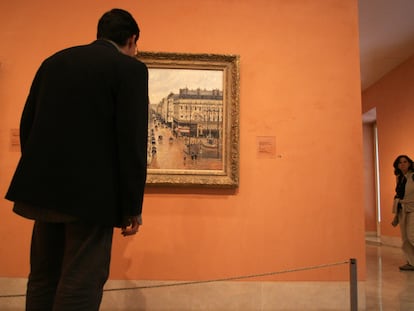The Yellow House of the Blue Rider: Art show honors Gabriele Münter, co-founder of German expressionism
An exhibition at the Thyssen-Bornemisza Museum in Madrid brings back memories of the lakeshore home that the artist and her famous partner Wassily Kandinsky shared in Murnau before the war tore them apart

I enter the Thyssen Museum in Madrid to see the exhibition of works by Gabriele Münter (1877-1962). One of the great female painters of German expressionism, she’s finally being properly recognized alongside her male counterparts.
From the first paintings I see, such as Breakfast of the Birds (1934), I’m reminded of the house where Gabriele lived with Wassily Kandinsky, in the German village of Murnau, which I visited last winter. Kandinsky was her painting teacher and eventually became her romantic partner.
After travelling together through Europe and North Africa, they decided that they needed a house where they could paint and lead a stable life. They fell in love with Murnau, a village on the shores of Lake Staffel, at the foot of the Bavarian Alps. Gabriele bought the yellow house, which was built according to the model of the homes in the area. They lived there from 1908. They became inseparable from the Russian painters Marianne von Werefkin and Alexei von Jawlensky. All of them were possessed by the effervescence of portraying landscapes and human figures as never before.
I look at the many paintings with snowy landscapes that are on display at Münter’s exhibition in Madrid. I remember the whiteness of the snow-covered fields and the frozen lakes of Murnau, with their soft winter light. When I entered the snowy garden in the house-museum, I was struck by the way the furniture and staircase had been painted. In the explanations offered in the museum, I read that when they bought the house, the couple set to work painting the walls and decorating the furniture. The interior of the house , which was in such contrast to the white and quiet landscape that day, is, in and of itself, a work of art. The walls of the rooms are adorned with bright colors — red, blue, green — and the wooden staircase is lined with paintings of horsemen, trees and flowers, just like one finds on traditional rural furniture.
I move on to another room in the exhibition and stop in front of the painting Boating (1910). In the image, Gabriele Münter is rowing the boat, with her back to me, Kandinsky is standing, while two others are sitting: Marianne von Werefkin and her son.
I think of all those artists who passed by the yellow house; the composer Arnold Schönberg, as well as the painters Macke and Franz Marc who, together with their hosts, founded the group Der Blaue Reiter (“The Blue Rider”), a key part of modern expressionism. All the artists who visited Gabriele and Kandinsky, and whose portraits hang on the walls of the yellow house, gave a new direction to 20th-century art. Some, like Kandinsky and Jawlensky, took their spiritual quest in an entirely new direction: abstract art.
In 1914, the war put an end to the joy and vitality of the group. From one day to the next, Kandinsky — being a Russian citizen — was suddenly classified as an enemy of Germany. After a few months spent with Gabriele safe in neutral Switzerland, he returned alone to Russia, where he married. Gabriele spent the war years in Stockholm, Sweden.
During Nazism and World War II, she managed to save her paintings, as well as those by Kandinsky and other expressionists. The Nazis considered their work to be degenerate art, hence she had to hide everything in the basement of her house. She was assisted by her husband, the art historian Johannes Eichner. The Gestapo never discovered the treasure.
In 1957, when Gabriele turned 80, she bequeathed her collection to the Städtische Galerie in Munich. The painter spent the rest of her life in Murnau, where she died in 1962.
Sign up for our weekly newsletter to get more English-language news coverage from EL PAÍS USA Edition
Tu suscripción se está usando en otro dispositivo
¿Quieres añadir otro usuario a tu suscripción?
Si continúas leyendo en este dispositivo, no se podrá leer en el otro.
FlechaTu suscripción se está usando en otro dispositivo y solo puedes acceder a EL PAÍS desde un dispositivo a la vez.
Si quieres compartir tu cuenta, cambia tu suscripción a la modalidad Premium, así podrás añadir otro usuario. Cada uno accederá con su propia cuenta de email, lo que os permitirá personalizar vuestra experiencia en EL PAÍS.
¿Tienes una suscripción de empresa? Accede aquí para contratar más cuentas.
En el caso de no saber quién está usando tu cuenta, te recomendamos cambiar tu contraseña aquí.
Si decides continuar compartiendo tu cuenta, este mensaje se mostrará en tu dispositivo y en el de la otra persona que está usando tu cuenta de forma indefinida, afectando a tu experiencia de lectura. Puedes consultar aquí los términos y condiciones de la suscripción digital.
More information
Archived In
Últimas noticias
Christmas loses its festive spirit: ICE fears cast shadow over religious celebrations
All the effects of gentrification in one corner of Mexico’s Colonia Roma
Palestinian reporter Youmna El Sayed: ‘My family told me I had to choose between being a journalist or a mother’
Russell Tovey: ‘I was advised many times not to come out, I don’t think there was many people who’d done that — and I feel really proud that I’m one of those that did’
Most viewed
- Families demand repatriation of bodies of Colombians who died in Ukraine: ‘This war is a slaughterhouse for foreigners’
- The low-cost creative revolution: How technology is making art accessible to everyone
- Liset Menéndez de la Prida, neuroscientist: ‘It’s not normal to constantly seek pleasure; it’s important to be bored, to be calm’
- Christian Louboutin: ‘Young people don’t want to be like their parents. And if their parents wear sneakers, they’re going to look for something else’
- ‘El Limones’ and the growing union disguise of Mexican organized crime











































